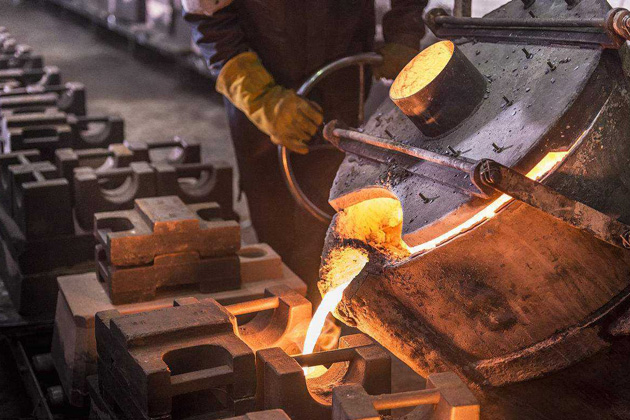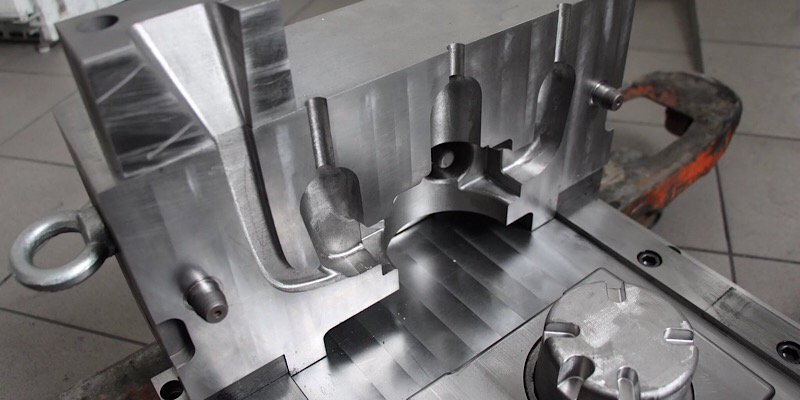How Aluminum Foundry Wisconsin still be relevant in casting
Wiki Article
Just How Aluminum Foundry Adds To Advancements in Aerospace Design
Aluminum factories are indispensable to developments in aerospace engineering. They produce light-weight, high-strength components that are crucial for contemporary airplane. Through advanced casting techniques, these foundries produce complicated geometries that boost structural honesty. In addition, the growth of superior Aluminum alloys supports the sector's concentrate on gas efficiency and sustainability. Challenges remain in the production process. Understanding these elements exposes the profound effect of Aluminum on air travel's future.The Significance of Lightweight Products in Aerospace Design
As the aerospace sector continues to progress, the value of lightweight materials ends up being increasingly apparent. The need for efficiency and sustainability drives engineers to focus on using materials that minimize general weight without endangering structural stability. Light-weight products, particularly Aluminum, play an essential function in improving gas efficiency, enhancing payload capability, and raising the general performance of aircraft.In addition, the integration of these materials enables for cutting-edge layouts, making it possible for manufacturers to produce more aerodynamic shapes that can stand up to severe problems. The decrease in weight not just reduces operational prices yet additionally adds to a lowered ecological footprint, lining up with global initiatives towards sustainability in aeronautics.
Advanced Spreading Techniques in Aluminum Foundries
Advanced spreading techniques in Aluminum foundries play an essential duty in aerospace engineering by allowing the production of precise and lightweight components. Innovations in mold and mildew layout and accuracy casting processes are important in achieving ideal performance and architectural stability. Additionally, the advancement of light-weight alloys enhances the general performance and efficiency of aerospace applications.Ingenious Mold Layout
Innovative mold and mildew design plays an important role in the performance and effectiveness of Aluminum factories, especially within the aerospace market. By leveraging innovative materials and methods, modern mold and mildews can be engineered to endure high temperatures and stress, ensuring peak efficiency during the spreading procedure. These layouts typically incorporate intricate geometries that enable the manufacturing of lightweight yet structurally audio elements, important for aerospace applications. Additionally, making use of computer-aided design (CAD) software program helps with accurate modeling, making it possible for factories to improve and mimic mold and mildew designs before physical manufacturing starts. This not only improves the top quality of cast components however likewise decreases waste and preparation, leading to considerable price savings. Generally, innovative mold style is a keystone of progress in Aluminum Foundry technology for aerospace engineering.Accuracy Casting Processes
The effectiveness of ingenious mold and mildew layouts seamlessly integrates with accuracy casting procedures, which are necessary for generating top notch Aluminum elements in aerospace engineering. These processes, including sand casting, pass away spreading, and financial investment spreading, assure the production of intricate geometries with limited tolerances. Advanced strategies like vacuum casting and stress pass away casting enhance the integrity and surface finish of the final products. Precision casting lessens product waste while making best use of the mechanical buildings of Aluminum, essential for aerospace applications. Additionally, using real-time surveillance and advanced simulation devices throughout the spreading procedure enables instant modifications, causing enhanced quality assurance. Jointly, these accuracy spreading procedures placement Aluminum shops at the center of aerospace advancement, sustaining the market's need for dependability and efficiency.Light-weight Alloy Development
As aerospace engineers seek to improve fuel effectiveness and performance, lightweight alloy growth becomes a vital focus in Aluminum shops. These factories utilize advanced spreading techniques to develop alloys that provide premium strength-to-weight proportions. Developments in alloy composition, including the incorporation of components like lithium and magnesium, allow the production of products that stand up to severe conditions while reducing total aircraft weight. Strategies such as die casting and investment spreading facilitate the precision production of complicated forms, which are important for aerospace applications. Additionally, recurring research study intends to optimize these alloys for boosted mechanical properties and enhanced resilience. By focusing on light-weight alloy growth, Aluminum shops considerably add to the evolution of aerospace engineering, leading the way for more sustainable and efficient aircraft styles.
Enhancing Structural Honesty Via Aluminum Components
Aluminum parts offer substantial benefits in boosting architectural honesty within aerospace design. Their light-weight nature adds to total efficiency while maintaining toughness, which is important for aircraft performance. In addition, the stress and anxiety resistance residential or commercial properties of Aluminum help ensure the longevity and reliability of aerospace structures under various functional problems.
Lightweight Product Conveniences
While typical products usually endanger weight for toughness, utilizing Aluminum parts in aerospace design supplies considerable advantages in architectural integrity. Aluminum's light-weight nature adds to general style effectiveness, enabling more structured airplane that take in less gas, therefore enhancing sustainability. The material's exceptional strength-to-weight proportion guarantees that elements maintain resilience without including unneeded mass. This quality cultivates improved performance and agility in flight, in addition to optimized haul capacities. Additionally, Aluminum's resistance to corrosion lengthens the life-span of aerospace structures, reducing upkeep costs and improving safety. As producers increasingly embrace Aluminum alloys, the aerospace market experiences a transformative change towards a lot more effective and effective engineering remedies that prioritize both efficiency and ecological obligation.Stress And Anxiety Resistance Properties
Different products possess distinct buildings, Aluminum's exceptional tension resistance stands out as a critical factor in enhancing the architectural integrity of aerospace elements. This resistance plays an essential duty in guaranteeing that aircraft can stand up to numerous functional stress and anxieties, consisting of exhaustion, impact, and environmental conditions. Aluminum alloys, particularly engineered for aerospace applications, display high tensile toughness while maintaining light-weight qualities, making it possible for engineers to develop more reliable frameworks - Aluminum Foundry. Additionally, the ability of Aluminum to withstand cyclic loading without substantial deformation adds to the long life and integrity of aerospace parts. As developments continue in Aluminum Foundry strategies, the development of stress-resistant Aluminum parts assures additional improvements in performance, safety and security, and efficiency throughout the aerospace sector, strengthening Aluminum's function as a preferred product in modern designFuel Effectiveness Improvements Driven by Aluminum Innovations
As the aerospace industry looks for to enhance fuel performance, cutting-edge uses Aluminum have actually emerged as an important service. Aluminum's lightweight nature especially lowers aircraft weight, allowing for reduced fuel usage during trip. This decrease in weight is crucial, as even small reductions can lead to significant renovations in overall fuel economic situation.Advanced Aluminum alloys, designed for improved strength and durability, enable producers to develop elements that preserve architectural stability while reducing mass - Aluminum Foundry. Additionally, the assimilation of Aluminum in airframes and engine parts assists in improved aerodynamics, adding to decreased drag and enhanced effectiveness
The adoption of Aluminum in aerospace not just fulfills the need for fuel-efficient design but likewise aligns with regulatory stress for reduced exhausts. As these innovations remain to develop, they play a substantial function in setting brand-new criteria for gas efficiency, making sure that the aerospace sector can fulfill expanding environmental and financial obstacles.

The Role of Aluminum in Sustainable Air Travel Practices
The raising emphasis on sustainable aviation techniques has get more placed Aluminum as an essential material in the mission Get More Information for greener airplane style. Known for its light-weight homes, Aluminum substantially minimizes airplane weight, bring about lower fuel consumption and emissions. Its recyclability even more boosts its sustainability profile, as Aluminum can be recycled forever without loss of quality. This particular sustains a circular economic situation within the aviation sector, decreasing waste and source deficiency.Improvements in Aluminum alloys have actually enhanced their stamina and deterioration resistance, permitting for longer service life and lowered maintenance needs. These advancements help with the advancement of much more efficient aircraft structures, contributing to total sustainability efforts. In addition, Aluminum's thermal conductivity plays a crucial duty in energy-efficient styles, enhancing systems such as warm exchangers. Jointly, these attributes highlight Aluminum's pivotal duty beforehand sustainable aviation, straightening with global initiatives targeted at reducing the environmental influence of air traveling.
Challenges Encountered by Aluminum Foundries in Aerospace Manufacturing
While Aluminum shops play an important function in aerospace production, they encounter considerable obstacles that can affect production efficiency and quality. One significant difficulty is the strict quality assurance requirements called for in the aerospace sector. Any type of problem can jeopardize safety and security and performance, demanding rigorous evaluation procedures that expand manufacturing timelines. Furthermore, foundries frequently contend with varying resources expenses, which can affect pricing and earnings. The intricacy of Aluminum alloys made use of in aerospace applications further complicates the production process, as exact solutions are crucial for attaining preferred mechanical residential properties. Knowledgeable labor shortages hinder the capacity to keep top notch production degrees. Environmental laws impose restrictions on exhausts and waste administration, needing shops to invest in lasting techniques, which can be cost-prohibitive. These elements jointly develop a landscape where Aluminum foundries must continuously adapt to satisfy the developing needs of aerospace manufacturing while ensuring security and conformity.Future Fads in Aluminum Applications for Aerospace Design
With improvements in modern technology and raising demands for effectiveness, the future of Aluminum applications in aerospace engineering is positioned for considerable transformation. The integration of cutting-edge Aluminum alloys and composites is expected to improve strength-to-weight ratios, resulting in even more fuel-efficient aircraft layouts. Additionally, innovations in additive manufacturing strategies will permit the production of intricate Aluminum structures that were formerly difficult, optimizing efficiency and reducing waste.
Lasting techniques will certainly play an important duty, with a growing focus on recycling Aluminum to reduce ecological impact. The aerospace field is likely to accept smarter manufacturing processes, such as automation and synthetic knowledge, making certain better and accuracy in Aluminum elements. Partnerships in between Aluminum shops and aerospace business will foster research study and development, paving the Visit Website means for brand-new applications that meet the stringent requirements of modern aerospace design. Generally, the future looks assuring for Aluminum's duty fit the skies
Frequently Asked Questions
What Are the Environmental Effects of Aluminum Manufacturing in Aerospace?
The environmental effects of Aluminum manufacturing in aerospace consist of considerable energy intake, greenhouse gas emissions, and habitat interruption. Furthermore, mining processes can lead to soil degradation and water contamination, increasing issues about sustainability and environmental balance.How Does Aluminum Compare to Other Products in Aerospace Applications?
Aluminum offers a distinct combination of lightweight residential properties, deterioration resistance, and cost-effectiveness compared to other products. Its high strength-to-weight proportion makes it particularly beneficial for aerospace applications, improving fuel efficiency and total efficiency in aircraft layout.What Credentials Do Aluminum Foundry Workers Requirement for Aerospace Projects?
Aluminum Foundry workers require specific training in metallurgy and casting strategies, in addition to expertise of aerospace sector requirements. Certifications in quality control and safety procedures are additionally important to ensure conformity with stringent aerospace job demands.Exist Any Security Worry About Making Use Of Aluminum in Aerospace Engineering?
Safety concerns pertaining to Aluminum in aerospace engineering include susceptibility to fatigue, corrosion, and anxiety cracks. Correct treatment and alloy selection are vital to alleviate these threats, ensuring architectural honesty and overall safety in aerospace applications.Just How Does Aluminum Recycling Benefit the Aerospace Market?
Aluminum recycling substantially profits the aerospace market by decreasing material expenses, reducing environmental influence, and conserving power. This sustainable method improves the sector's effectiveness while advertising the use of light-weight, high-performance components in aircraft manufacturing.Advanced casting strategies in Aluminum foundries play a crucial function in aerospace design by enabling the manufacturing of light-weight and exact components. Cutting-edge mold and mildew layout plays a vital function in the effectiveness and efficiency of Aluminum foundries, particularly within the aerospace industry. As aerospace engineers seek to enhance gas effectiveness and performance, lightweight alloy growth comes to be an essential focus in Aluminum foundries. Aluminum alloys, especially crafted for aerospace applications, show high tensile stamina while keeping light-weight attributes, allowing designers to develop more efficient frameworks. Partnerships in between Aluminum factories and aerospace companies will certainly promote research and growth, leading the way for new applications that satisfy the strict needs of contemporary aerospace engineering.
Report this wiki page